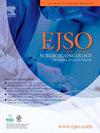From conventional minimally invasive to robotic-assisted Ivor Lewis esophagectomy – A Nordic single-center retrospective study
IF 2.9
2区 医学
Q2 ONCOLOGY
引用次数: 0
Abstract
Background
High-quality studies from Asia have demonstrated that robotic assisted minimally invasive esophagectomy (RAMIE) is a feasible and comparable alternative to conventional minimally invasive esophagectomy (MIE), evidence regarding its application to Western patients remains limited. This study evaluates the short-term outcomes during the initial phase of RAMIE implementation in comparison to the previous standard MIE technique in a Nordic center.
Methods
A retrospective single center study of prospectively registered data, comparing short-term outcomes between the final 100 patients operated with MIE and the first 100 patients operated with RAMIE. The primary outcome was the total number of lymph nodes harvested. Secondary outcomes included postoperative pneumonia, anastomotic leakage, serious complications (Clavien Dindo 3), length of operation, length of hospital stay and resection margin status. An inverse probability weighting model and regression analysis was conducted.
Results
200 patients were included (RAMIE n = 100, MIE n = 100). Matched groups (RAMIE n = 96, MIE n = 97) showed no difference in total number of lymph nodes harvested (RAMIE 22.1 vs. MIE 23.7, p = 0.50). RAMIE had higher postoperative pneumonia risk (OR = 2.3, p < 0.01), longer length of operation (+33.9 min, p < 0.01) and marginally increased risk of anastomotic leakage (OR = 2.4, p = 0.05). Comparing the last 50 patients operated with RAMIE to the MIE group, there was no difference in length of operation (OR = 10.3, p = 0.43).
Conclusion
The short-term oncological outcomes and safety remain secure even during the initial phases of RAMIE implementation in a Nordic cohort. The perioperative outcome for some measures after RAMIE were inferior to MIE, potentially related to learning curve aspects.
从传统微创到机器人辅助Ivor Lewis食管切除术-北欧单中心回顾性研究
来自亚洲的高质量研究表明,机器人辅助微创食管切除术(RAMIE)是一种可行的替代传统微创食管切除术(MIE)的方法,但关于其在西方患者中的应用证据仍然有限。本研究评估了RAMIE实施初期的短期结果,并与北欧中心先前的标准MIE技术进行了比较。方法回顾性单中心研究前瞻性登记资料,比较最后100例MIE患者和前100例RAMIE患者的短期预后。主要结果是淋巴结的总数量。次要结局包括术后肺炎、吻合口漏、严重并发症(Clavien Dindo≥3)、手术时间、住院时间和切缘状况。建立了逆概率加权模型并进行了回归分析。结果纳入200例患者(RAMIE n = 100, MIE n = 100)。配对组(RAMIE n = 96, MIE n = 97)淋巴结总数无差异(RAMIE 22.1 vs MIE 23.7, p = 0.50)。RAMIE术后肺炎风险较高(OR = 2.3, p < 0.01),手术时间较长(+33.9 min, p < 0.01),吻合口漏风险略有增加(OR = 2.4, p = 0.05)。最后50例患者行RAMIE手术与MIE组比较,手术时间无差异(OR = 10.3, p = 0.43)。结论:在北欧队列中,即使在RAMIE实施的初始阶段,短期肿瘤预后和安全性仍然是安全的。RAMIE术后一些措施的围手术期结果不如MIE,可能与学习曲线方面有关。
本文章由计算机程序翻译,如有差异,请以英文原文为准。
求助全文
约1分钟内获得全文
求助全文
来源期刊

Ejso
医学-外科
CiteScore
6.40
自引率
2.60%
发文量
1148
审稿时长
41 days
期刊介绍:
JSO - European Journal of Surgical Oncology ("the Journal of Cancer Surgery") is the Official Journal of the European Society of Surgical Oncology and BASO ~ the Association for Cancer Surgery.
The EJSO aims to advance surgical oncology research and practice through the publication of original research articles, review articles, editorials, debates and correspondence.
 求助内容:
求助内容: 应助结果提醒方式:
应助结果提醒方式:


